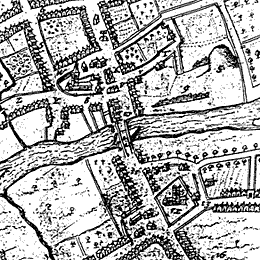History of Bedford
Bedford is thought to have been in existence well before the first documented mention around 913. King Edward the Elder, the son of Alfred the Great, forced the inhabitants to yield to his authority, the King then ordered the building of the borough south of the river. This greatly increased the security of the area, and together with the fertility of the region, caused rapid expansion during the second quarter of the century.
Early Period – History of Occupation
The fertile Ouse Valley seems to have attracted settlers from an early age. There are indications of Neolithic settlements from around 3500 BC near to Cardington, Kempston and Eaton Socon.
Excavations indicate communities during the Belgic Iron Age. Immigrants from Northern Europe settled in the valley around 100 BC, archaeological finds for this period are in the northern part of the County including the villages of Bromham and Wyboston. Burial sites are known about at Kempston and Felmersham.
There is also substantial evidence of Roman settlements; a site at Odell dates from the second century. Around AD 400, Rome abandoned Britain and during the next centuries Anglo Saxons and Vikings settled in the area. The main archaeological evidence for this comes from burial sites.
Bedford In The Medieval Period
Bedford now had a castle, which was first documented when King Stephen lay siege to the fortress in 1130, the siege failed.
The original site is thought to be bounded by the present High Street, Embankment, Newnham Road, and Ram Yard.
The De Beauchamp family occupied the Castle, until 1215. In 1215 William De Beauchamp allied himself with an anti-royal faction. Baron Falke De Breaute, on behalf of the King, lay siege to the castle. The Baron really went beyond his remit, and the resultant plunder and pillage caused a lot of unrest.
The last chapter in the life of Bedford Castle happened in 1224. The final siege, under Henry III, caused the surrender of the Castle. Falke was absent from the Castle during this conflict and was then exiled abroad. King Henry executed about 80 of the inhabitants by hanging, and ordered the destruction of the Castle. The lands were returned to the de Beauchamp family.
Despite this great conflict, the town recovered and thrived, and the tax returns of 1297 showed a wide range of trades being undertaken.
Post Medieval Bedford
an excerpt from a map of Bedford made in 1610. showing the extent of the town in the early part of the 17th century.
John Bunyan
During this period Bedford’s most famous son was born. John Bunyan came into this world in 1628. The son of a tinker, John Bunyan followed his father’s trade and during the civil war volunteered, or was conscripted, for service in Cromwell’s army.
Once the civil war was over, he returned to his trade which he found rather socially boisterous. This style of life worried the young man’s conscience and the emergence of the newer simpler forms of worship appealed to John Bunyan.
The social and religious norms of the period were strictly enforced. To say that it was a totalitarian system would not be an unkind description. People were fined for non-attendance at church, making worship obligatory providing it was the official version. The religious dissenters movement had difficulties and they were put under severe pressure.
John Bunyan had found that he was a gifted and mesmeric preacher, and, by refusing to stop, he fell foul of the authorities and was imprisoned for 12 years.
That his beliefs would not allow him to recant was the reason for the length of stay in prison. King Charles II granted an amnesty for religious prisoners and he was released in 1672. The King was later forced to withdraw the amnesty and John Bunyan was returned to prison. During this period between 1673 to 1677, The Pilgrim’s Progress was written, and published the year following his release in 1678.
John Bunyan continued to preach and write until his death in 1688.
Development Of The Town
During the next 150 years or so important developments took place. The most significant was the opening of the River Ouse Navigation to Kings Lynn.
Bedford in the 19th Century
With the development of the railways, Bedford became part of the network and travel and communications were much easier. The period around 1850 saw the population increase to 9000.
As the town developed, newer manufacturing industries based their factories in the town. During the past years a cottage industry of lace making had been wide spread, but the mechanisation of the process around 1900 killed off this enterprise.
During the earlier parts of the 1900’s the village of Cardington played a significant role in the airship industry. People who were called for their post-Second World War National Service in the Royal Air Force (RAF), caught their first glimpse of service life when they went to Cardington to be kitted out in their uniforms.
Modern Times
The town is a significant contributor to the modern economy. The range of industries covers the more traditional type of activity to modern electronics and computing companies.
The local rural economy is still largely agricultural with over 70% of the land devoted to farming.
The education standards of the town are excellent, with nationally famous schools in the private sector and high standard schools in the state system.

